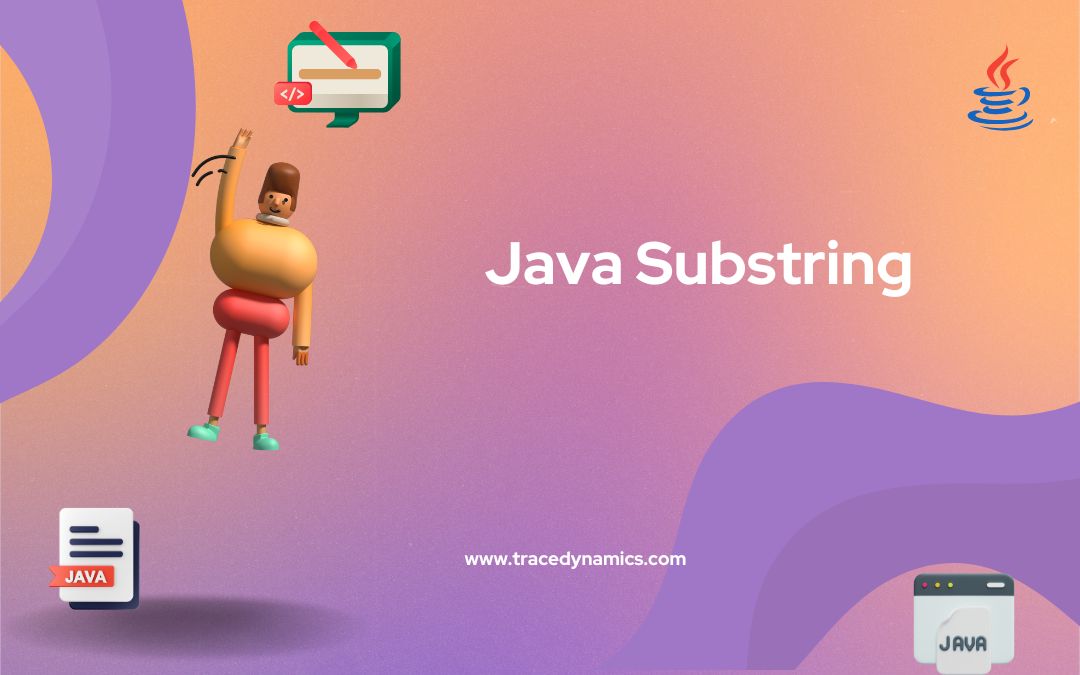
Java
In the world of Java programming, string manipulation is key, and the Java substring method is crucial for robust application development.
Unveiling the Mystery: Demystifying substring
The substring method in Java’s String class offers two variants:
- substring(int beginIndex): Extracts a substring from the specified
beginIndex to the end of the string.
- substring(int beginIndex, int endIndex): Allows precise extraction from
beginIndex to endIndex.
Exploring the Capabilities: Illuminating Examples
- Example: Extracting the First N Characters
String message = "Welcome to the world of Java!";
String firstFive = message.substring(0, 5); // "Welco"
System.out.println(firstFive);
This example extracts the first five characters (“Welco”) from the string.
- Example: Isolating a Specific Substring
String movieTitle = "The Shawshank Redemption";
String titlePart = movieTitle.substring(10, 19); // "Redemption"
System.out.println(titlePart);
This example isolates the substring “Redemption” from the movie title.
- Example: Extracting Delimited Substrings
String list = "apple,banana,cherry";
String firstFruit = list.substring(0, list.indexOf(",")); // "apple"
System.out.println(firstFruit);
This code snippet retrieves the first fruit (“apple”) from a comma-separated list, utilizing the indexOf method to locate the delimiter.
- Example: Building Dynamic Substrings
Java
String name = "John Doe";
int age = 30;
String greeting = "Hello, " + name.substring(0, name.indexOf(" ")) + "! You are " + age + " years old.";
System.out.println(greeting);
This example dynamically constructs a greeting by extracting the first name using substring and concatenating it with other elements.
Beyond the Basics: Navigating the Complexities
As with any powerful tool, the substring method has its own intricacies:
- Index Out of Bounds: Accessing non-existent indexes throws IndexOutOfBoundsException. Always ensure valid indices.
- Empty Substrings: Extracting beyond the string length results in an empty string.
- Performance: Repeatedly extracting substrings can impact performance. Consider using StringBuilders for frequent manipulations.
Embracing the Power: Harnessing the Potential
By understanding the intricacies and versatile applications of the substring method, you can unlock its potential to:
- Parse and manipulate data: Extract specific information from strings, like usernames or product names.
- Validate user input: Ensure input fits within specific criteria by extracting relevant parts.
- Format and customize strings: Create dynamic greetings, build formatted messages, and personalize content.
Unveiling the Synergies: Combining substring with Other Methods
The true power of substring lies in its synergy with other string manipulation methods:
- charAt(int index): Extracts a single character at a specific index.
- indexOf(String str): Finds the first occurrence of a substring within the string.
- lastIndexOf(String str): Finds the last occurrence of a substring within the string.
- replace(String oldValue, String newValue): Replaces all occurrences of a substring with another.
Engaging Examples: Unveiling Hidden Potential
Explore the versatile applications of substring through practical examples:
- Example: Extracting Substrings Based on Delimiters
String names = "John,Mary,Peter";
String[] nameList = names.split(",");
for (String name : nameList) {
System.out.println(name);
}
This code snippet utilizes split to split the string based on the comma delimiter and extracts each individual name using substring within the loop.
- Example: Replacing Specific Substrings
String url = "https://www.example.com/products";
String newUrl = url.replace("/products", "/categories");
System.out.println(newUrl);
TThis example demonstrates how to replace the “/products” part of a URL with “/categories” using the replace method.
- Example: Extracting and Formatting Specific Data
String priceString = "$12.50";
double price = Double.parseDouble(priceString.substring(1));
System.out.println(price);
This code snippet extracts the price value (excluding the leading “$”) from a string using substring and converts it to a double using parseDouble.
- Example: Building Dynamic Messages with Substrings
Java
String firstName = "John";
String lastName = "Doe";
String greeting = "Hello, Mr. " + lastName.substring(0, 1) + ". " + firstName + ", how are you?";
System.out.println(greeting);
This example dynamically constructs a personalized greeting by extracting the first letter of the last name and combining it with other elements using substring.
Beyond the Horizons: Exploring Advanced Applications
Discover advanced uses of substring, such as building custom string tokenizers, text normalization, and creating search algorithms.
Conclusion: Mastering the Art of String Substrings
Deepening your understanding of substring and its combinations with other methods enhances your string manipulation skills in Java.
Frequently Asked Questions
What is the substring method in Java?
The substring method in Java is used to extract a part of a string based on specified indices.
How do you use the substring method?
The substring method is used by specifying the start index and optionally the end index in the format string.substring(startIndex, endIndex).
What happens if the end index is omitted in substring?
If the end index is omitted, substring extracts the part of the string from the start index to the end of the string.
Does substring include the character at the end index?
No, the character at the end index is not included; substring stops extraction right before the end index.
Can substring handle negative indices?
No, substring in Java does not support negative indices and will throw an IndexOutOfBoundsException.
What exception can substring throw?
Substring can throw IndexOutOfBoundsException if the start or end indices are invalid.
How can substring be used with other string methods?
Substring can be combined with methods like indexOf to extract specific parts of a string dynamically.
Is substring case-sensitive?
Yes, the substring method is case-sensitive when extracting parts of a string.
Can substring modify the original string?
No, substring does not modify the original string; it returns a new string with the extracted part.
How is substring useful in data parsing?
Substring is useful in data parsing to extract and process specific segments of strings, such as parsing structured data.

Java
Ternary Operator Java: In the vibrant world of Java programming, efficiency reigns supreme. The ternary operator, known as the conditional operator, is a powerful tool to condense complex conditional statements into elegant expressions.
Unveiling the Mystery: Anatomy of the Ternary Operator
The ternary operator is represented by ? : and operates on three operands:
- Condition: A boolean expression determining which operand to evaluate.
- Expression1: Evaluated if the condition is true.
- Expression2: Evaluated if the condition is false.
condition ? expression1 : expression2
Unleashing the Power: Engaging Examples
- Example: Simplifying If-Else Statements
int age = 20;
String message = age >= 18 ? "Welcome!" : "Access denied";
- Example: Assigning Default Values
String name = "";
String greeting = name.isEmpty() ? "Hello stranger" : "Hello " + name;
- Example: Conditional Operations
int maximum = a > b ? a : b;
- Example: Chained Ternary Operators
int number = -5;
String sign = number > 0 ? "Positive" : number < 0 ? "Negative" : "Zero";
Beyond the Basics: Navigating the Pitfalls
While powerful, the ternary operator requires careful consideration for readability, error proneness, and readability of alternatives like if-else statements.
Embrace the Efficiency:
Understanding the Java ternary operator can enhance your code's efficiency, conciseness, and elegance. With practice, this versatile tool can become a cornerstone of your Java programming.
Enhancing Code Readability and Maintenance
The Java ternary operator excels in making code more readable and maintainable. It shines in scenarios where a concise expression replaces a bulky if-else block. This succinctness is particularly beneficial in setting variable values or making simple decisions. However, it's crucial to avoid overuse, as complex nested ternary operations can hinder readability.
Ternary Operator in Functional Programming
In Java's functional programming, particularly with lambda expressions and streams, the ternary operator provides a streamlined way to implement conditional logic. Its compact form is ideal for inline operations within streams, enhancing the declarative programming style of Java.
Performance Considerations
While the ternary operator can be more concise than if-else statements, its impact on performance is generally minimal. The choice between ternary and if-else should thus be based more on readability and the specific context of the code.
Best Practices and Use Cases
Best practices for the ternary operator include using it for simple conditional assignments and readability improvements. It's most effective when the conditional logic is straightforward and can be expressed cleanly in a single line. Complex conditions or operations are better handled with traditional if-else statements for clarity.
By integrating these insights into your Java programming, you can leverage the ternary operator's efficiency while maintaining code clarity and elegance.
Frequently Asked Questions
What is the ternary operator in Java?
The ternary operator in Java is a conditional operator that serves as a compact form of the if-else statement.
How is the ternary operator represented in Java?
In Java, the ternary operator is represented by the symbols ? and :, forming 'condition ? expression1 : expression2'.
Can the ternary operator improve Java code readability?
Yes, the ternary operator can enhance code readability by condensing simple conditional statements into a single line.
Is the ternary operator in Java more efficient than if-else statements?
The efficiency of the ternary operator is similar to if-else statements, but it can make code more concise.
Can the ternary operator be nested in Java?
Yes, ternary operators can be nested in Java, but this may impact readability.
Is the ternary operator suitable for complex conditions?
For complex conditions, traditional if-else statements may be more readable than the ternary operator.
How does the ternary operator handle null values in Java?
The ternary operator can handle null values but requires careful handling to avoid NullPointerException.
Can the ternary operator return different data types?
No, both expressions of the ternary operator must return the same type or compatible types in Java.
Is the ternary operator widely used in Java programming?
Yes, it's commonly used for its conciseness in appropriate scenarios.
How does the ternary operator work with Java streams?
The ternary operator can be effectively used within Java streams for concise conditional processing.
Can the ternary operator be used in Java lambda expressions?
Yes, it fits well within lambda expressions for brief conditional logic.
What are the best practices for using the ternary operator in Java?
Best practices include using it for simple conditions and ensuring that it enhances, not hinders, readability.
Does the ternary operator affect Java code performance?
The impact on performance is negligible; the choice should be based on readability and clarity.
How can misuse of the ternary operator be avoided in Java?
Avoid overusing it, especially in complex conditions where it can reduce code clarity.
What are common pitfalls in using the ternary operator?
Common pitfalls include reduced readability due to overuse and improper handling of null values.

C++, Java, Javascript, Python
In the realm of data structures, linked lists hold a unique position for their dynamic nature and flexibility. This article explores the art of linked list reversal across five popular programming languages: C, C++, Python, JavaScript, and Java.
What is a Linked List
A linked list, used in computer programming, is a linear data structure comprising a sequence of elements. Each element, or node, connects to another in the sequence through a ‘link’ or ‘pointer’. Unlike arrays, linked list elements don’t occupy contiguous memory locations. A node holds data and a reference to the next node. This structure facilitates efficient insertion and removal of elements without the need to shift elements in memory. Linked lists are particularly useful when the number of elements is variable or unknown.
Understanding the Challenge:
A linked list is a linear collection of nodes, where each node contains data and a reference to the next node in the sequence. Reversing a linked list involves altering the references of each node to reverse the order of elements.
Unveiling the Mystery: Reverse a Linked List:
Let’s explore how to reverse a linked list in different programming languages.
- C: In C, the iterative approach using pointers and the struct keyword is common for linked list reversal.
struct Node {
int data;
struct Node* next;
};
struct Node* reverse_list(struct Node* head) {
struct Node* prev = NULL;
struct Node* curr = head;
while (curr) {
struct Node* next = curr->next;
curr->next = prev;
prev = curr;
curr = next;
}
return prev;
}
C++: C++ uses classes and templates, allowing more structured code for linked list reversal.
class Node {
public:
int data;
Node* next;
};
Node* reverse_list(Node* head) {
Node* prev = nullptr;
Node* curr = head;
while (curr) {
Node* next = curr->next;
curr->next = prev;
prev = curr;
curr = next;
}
return prev;
}
Python: Python simplifies linked list manipulation with built-in functionalities and straightforward iterative approaches.
class Node:
def __init__(self, data):
self.data = data
self.next = None
def reverse_list(head):
prev = None
curr = head
while curr:
next_node = curr.next
curr.next = prev
prev = curr
curr = next_node
return prev
JavaScript: JavaScript offers object literals and function closures for both iterative and recursive linked list reversal.
class Node {
constructor(data) {
this.data = data;
this.next = null;
}
}
function reverseList(head) {
let prev = null;
let curr = head;
while (curr) {
const next = curr.next;
curr.next = prev;
prev = curr;
curr = next;
}
return prev;
}
Java: Java uses classes and references, with both iterative and recursive approaches possible for linked list reversal.
class Node {
int data;
Node next;
public Node(int data) {
this.data = data;
this.next = null;
}
}
public class ReverseLinkedList {
public static Node reverseList(Node head) {
Node prev = null;
Node curr = head;
while (curr != null) {
Node nextTemp = curr.next;
curr.next = prev;
prev = curr;
curr = nextTemp;
}
return prev;
}
}
Choosing Your Weapon:
The most suitable approach for reversing a linked list depends on various factors, including language-specific features, code complexity, and personal preference.
Beyond the Challenge: Expanding Your Horizons:
Understanding linked list reversal is fundamental for mastering data structures and algorithms. This skill is crucial across various programming languages, empowering you to navigate the landscape of data structures confidently.
Frequently Asked Questions
What is a linked list in programming?
A linked list is a data structure consisting of nodes, each containing data and a reference to the next node in the sequence.
How do you reverse a linked list in C?
In C, you reverse a linked list by changing the next pointers of its nodes so that they point to the previous nodes in the list.
Is the approach to reverse a linked list in C++ different from C?
C++ follows a similar approach to C for reversing a linked list but often uses object-oriented concepts for implementation.
Can you reverse a linked list recursively in Python?
Yes, in Python, a linked list can be reversed recursively by reassigning the next pointers in each call stack.
What are the challenges of reversing a linked list in JavaScript?
In JavaScript, reversing a linked list can be tricky due to its dynamic typing and lack of pointers compared to languages like C and C++.
How do you handle memory management when reversing a linked list in Java?
In Java, memory management is handled by the Garbage Collector, which frees up memory once objects are no longer in use.
What is an iterative method for linked list reversal?
An iterative method involves looping through the list and reversing the direction of the pointers until the entire list is reversed.
Is it more efficient to reverse a linked list iteratively or recursively?
The efficiency depends on the context and constraints. Iterative methods are generally considered more memory-efficient.
How does a recursive reversal of a linked list work in C++?
Recursive reversal in C++ involves function calls where each node points to its previous node, effectively reversing the list.
What are the base cases for recursive linked list reversal in Python?
The base cases for recursion in Python include reaching the end of the list or a list with only one node.
Can an empty linked list be reversed in JavaScript?
Yes, but reversing an empty linked list in JavaScript will simply return the empty list as there are no nodes to reverse.
Do you need to update the head pointer when reversing a linked list in Java?
Yes, after reversing a linked list in Java, you need to update the head pointer to point to the new first node.
What is a 'Node' class in the context of linked lists?
The ‘Node’ class typically represents the structure of each element in a linked list, containing data and a reference to the next node.
In C, how do you handle pointers when reversing a linked list?
In C, pointers are manipulated to change the direction of the ‘next’ references in each node during the reversal process.
Are there any specific libraries needed for linked list reversal in Python?
No specific libraries are needed in Python for linked list reversal; it can be done using standard language features.

Java
java.lang.reflect.InvocationTargetException is a checked exception that encapsulates an exception thrown by an invoked method or constructor in Java. Delving into this exception, understanding its causes, and discerning how to handle it proficiently can significantly ameliorate the debugging process for Java developers.
Key Takeaways:
- Understanding: Grasping the essence of
java.lang.reflect.InvocationTargetException.
- Causes: Delving into common scenarios that trigger this exception.
- Handling: Strategies to unravel and handle this exception proficiently.
- Solutions: Practical solutions and workarounds to mitigate or resolve the issues leading to this exception.
- Community Insights: Leveraging communal knowledge and experiences to better cope with this exception.
Causes of java.lang.reflect.InvocationTargetException
Common Triggers
java.lang.reflect.InvocationTargetException is typically thrown when the Method.invoke() or Constructor.newInstance() of the reflection classes in Java is utilized, and the method or constructor being invoked throws an exception.
Table: Common Scenarios Leading to InvocationTargetException
| Scenario |
Description |
| Improper Method Call |
Invoking a method with incorrect parameters or at an improper time. |
| Runtime Exceptions |
Exceptions thrown during the execution of the invoked method or constructor. |
| Error Conditions |
Any error conditions encountered during the reflection operation. |
Reflection and Exception Wrapping
In Java, reflection is a powerful feature that allows for programmatic access to the information about Java classes and objects, including method invocation at runtime. However, when an invoked method throws an exception, it gets wrapped in a java.lang.reflect.InvocationTargetException, which adds an additional layer of abstraction to the original exception.
Handling java.lang.reflect.InvocationTargetException
Unwrapping the Exception
One of the primary steps in dealing with java.lang.reflect.InvocationTargetException is to unwrap the exception to discern the real cause of the problem. This entails obtaining the original exception, which can be achieved using the getTargetException() method on the InvocationTargetException instance.
Table: Steps to Unwrap InvocationTargetException
| Step |
Action |
| 1 |
Catch InvocationTargetException |
| 2 |
Call getTargetException() method |
| 3 |
Analyze the original exception for cause and resolution |
Logging and Debugging Techniques
Effective logging and debugging are indispensable in identifying and rectifying the issues leading to java.lang.reflect.InvocationTargetException. Employing robust logging frameworks and debugging tools can significantly expedite the troubleshooting process.
- Logging: Utilize logging frameworks like Log4j or SLF4J to log exceptions, including the stack trace, which can provide invaluable insights into the error conditions.
- Debugging: Leverage debugging tools integrated within IDEs to step through the code, inspect variables, and understand the flow leading to the exception.
Solutions and Workarounds
Configuring Java Console
Ensuring that the Java Console is correctly configured to display or log exceptions is crucial for diagnosing and resolving
java.lang.reflect.InvocationTargetException. The console can provide real-time feedback and error logging, aiding in identifying the root cause of the exception.
Table: Configuring Java Console for Exception Handling
| Action |
Description |
| Enable Console |
Ensure that the Java Console is enabled for displaying exceptions |
| Set Logging Level |
Adjust the logging level to capture the necessary details of exceptions |
| Review Logs |
Analyze the logs to identify the root cause and potential solutions |
Common Solutions
Here are some common solutions to mitigate or resolve the issues leading to java.lang.reflect.InvocationTargetException:
- Code Review: Conduct a thorough review of the code to identify and rectify any erroneous method calls or improper use of reflection.
- Exception Handling: Enhance exception handling mechanisms to catch and deal with exceptions proficiently.
- Testing: Employ rigorous testing methodologies to identify and fix potential issues before they escalate into production environments.
Community Insights
Tackling java.lang.reflect.InvocationTargetException proficiently often requires a blend of individual knowledge and communal insights. The Java community, being vast and diverse, has an array of experiences and solutions that could be highly beneficial.
Experiences from Seasoned Developers
Leveraging the experiences of seasoned developers who have tackled java.lang.reflect.InvocationTargetException can provide invaluable insights. Their strategies, solutions, and workarounds could serve as a cornerstone for understanding and resolving this exception.
Online Forums and Discussions
Engaging in online forums and discussions can lead to discovering novel solutions and gaining a deeper understanding of java.lang.reflect.InvocationTargetException
.
Practical Strategies
Implementing practical strategies can significantly ameliorate the handling of java.lang.reflect.InvocationTargetException. Here are some actionable steps:
- Error Logging: Ensure robust error logging is in place to capture all necessary information when the exception occurs.
- Code Analysis: Utilize static code analysis tools to identify potential issues that could lead to this exception.
- Community Engagement: Engage with the Java community to share experiences and solutions regarding java.lang.reflect.InvocationTargetException.
Wrapping Up
Through a comprehensive exploration of java.lang.reflect.InvocationTargetException, we have unearthed its causes, strategies for handling it, and practical solutions to mitigate or resolve the issues leading to this exception. The key to proficiently dealing with this exception lies in a blend of solid understanding, practical strategies, and leveraging communal insights. The resources, discussions, and experiences shared within the Java community are invaluable assets in navigating the challenges posed by java.lang.reflect.InvocationTargetException
.
Frequently Asked Questions (FAQs)
What is java.lang.reflect.InvocationTargetException?
java.lang.reflect.InvocationTargetException is a checked exception that arises when an invoked method or constructor throws an exception. This exception acts as a wrapper for the actual exception thrown.
How can I resolve java.lang.reflect.InvocationTargetException?
To resolve this exception, you need to: – Catch the InvocationTargetException. – Unwrap the actual exception using the getTargetException() method. – Investigate and fix the underlying cause of the actual exception.
Why is java.lang.reflect.InvocationTargetException a checked exception?
This exception is checked to ensure that developers handle or declare it, promoting better error management and robustness in Java applications.
Can java.lang.reflect.InvocationTargetException be prevented?
While it might not always be preventable, employing good programming practices, thorough testing, and robust exception handling can significantly minimize occurrences.
Where can I find more resources on handling java.lang.reflect.InvocationTargetException?
Numerous online communities, forums, and documentation, like StackOverflow, provide a wealth of information and solutions related to this exception.

Java
Java Initialize List: Java List is a part of the Java Collections Framework, which provides a flexible way to store, retrieve, and manipulate collections of objects. Lists are ordered collections and can contain duplicate elements. In Java, the List interface is implemented by classes such as ArrayList, LinkedList, and Vector. Let’s delve into different ways of initializing lists in Java, some advanced concepts, and practical examples to provide a hands-on understanding of using lists.
Key Takeaways
- Understanding various methods to initialize lists in Java.
- Comparing different initialization methods.
- Practical examples to initialize lists with specific values or conditions.
- Hands-on understanding of manipulating list of lists.
- Real-world scenarios where initializing lists play a crucial role.
Ways to Initialize Java Lists
Using Constructors
Java provides constructors for ArrayList, LinkedList, and Vector which can be used to initialize lists. Here’s an example
using ArrayList:
List list = new ArrayList<>();
| Constructor |
Description |
| ArrayList() |
Creates an empty list. |
| ArrayList(Collection c) |
Creates a list initialized with the elements of the specified collection. |
| LinkedList() |
Creates an empty linked list. |
| LinkedList(Collection c) |
Creates a linked list initialized with the elements of the specified collection. |
Using Arrays.asList() Method
Another way to initialize initialize lists in Java is using the Arrays.asList() method. This method allows you to create a fixed-size list backed by an array.
List list = Arrays.asList("Java", "Python", "C++");
Using Collections Class Methods
Java’s Collections class provides static methods to initialize lists in a single line.
List list = new ArrayList<>(Collections.nCopies(3, "Hello"));
Comparison of Different Initialization Methods
Different methods of list initialization in Java have their pros and cons. Constructors are straightforward but verbose. The Arrays.asList() method is concise but creates a fixed-size list. On the other hand, methods from the Collections class are powerful but might be less intuitive for beginners.
| Method |
Pros |
Cons |
| Using Constructors |
Simple, Flexible |
Verbose |
| Using `Arrays.asList()` |
Concise |
Fixed-size, Backed by an array |
| Using `Collections` Class Methods |
Powerful, Single-line initialization |
Less intuitive for beginners |
Initializing Lists with Specific Values
Using Loops
Looping is a common method to initialize lists with specific values. Below is an example of how you can use a for-loop to initialize a list with numbers 1 to 10:
List list = new ArrayList<>();
for (int i = 1; i <= 10; i++) {
list.add(i);
}
Using Java Streams
Java 8 introduced Streams, which provide a more declarative approach to initialize lists.
List list = IntStream.range(1, 11).boxed().collect(Collectors.toList());
Java List of Lists
A list of lists, also known as a 2D list, is a list where each element is a list. Below is an example of how to initialize a list of lists in Java:
List list = Arrays.asList("Java", "Python", "C++");
Practical Examples of Java List Initialization
Utilizing Java Lists effectively in real-world scenarios requires a good grasp of how to initialize them according to the specific needs of a project. Below are some practical examples that demonstrate the versatility and convenience of initializing lists in Java.
Initializing Lists in Real-world Scenarios
In projects, lists often need to be initialized with values from databases, files, or user input. Here's an example of initializing a list from a database result set:
List list = new ArrayList<>();
while (resultSet.next()) {
list.add(resultSet.getString("columnName"));
}
Frequently Asked Questions (FAQs)
How can I initialize a list with specific values in Java?
In Java, you can initialize a list with specific values using several methods including using a constructor with a collection, `Arrays.asList()` method, or using a loop.
What is the difference between an array and a list in Java?
Arrays are fixed in size while lists are dynamic. Lists come with several built-in methods that facilitate adding, removing, and fetching elements, which arrays do not have.
What are some common methods associated with Java List?
Some common methods include `add()`, `remove()`, `get()`, `set()`, `size()`, and `clear()`.
How can I convert an array to a list in Java?
You can use the `Arrays.asList()` method to convert an array to a list in Java.
Can a Java list contain duplicate elements?
Yes, Java lists can contain duplicate elements as they maintain the insertion order of elements.

Java
Unable to Find Valid Certification Path to Requested Target: In the realm of web security, ensuring a robust certification path is crucial for establishing trust between different systems. The error “unable to find valid certification path to requested target” often pops up when the certification path between a client and server is not trusted, misconfigured, or broken in some way. Understanding and troubleshooting this error is vital for anyone working in a networked environment, especially developers and system administrators.
Key Takeaways:
- Understanding the Error: Know the essence and implications of the error “unable to find valid certification path to requested target”.
- SSL Certificates: Grasping the basics of SSL certificates and their role in secure communications.
- Troubleshooting Steps: Learn the step-by-step approach to resolve this error and ensure a secure connection between client and server.
- Practical Solutions: Dive into practical solutions with real-world examples to fix certification path issues.
Understanding the Error
The error “unable to find valid certification path to requested target” is a common issue that arises due to problems in SSL/TLS certification paths. It’s often encountered when a client, such as a browser or a Java application, is unable to trust the certificate presented by the server.
Common Scenarios
- Network Misconfigurations: Incorrect network settings can lead to this error, especially in complex network environments.
- Invalid or Expired Certificates: Certificates that are either expired or not valid according to the client’s truststore can trigger this error.
- Proxy and Firewall Settings: Sometimes, firewall or proxy settings can block the client from accessing the server securely.
Understanding SSL Certificates and Certification Paths
SSL certificates play a pivotal role in establishing a secure communication channel between a client and server. They are digital passports that provide authentication and enable encrypted connections.
Basics of SSL Certificates
- Issuance: Certificates are issued by trusted entities known as Certificate Authorities (CAs).
- Validation: They validate the identity of the certificate holder and provide encryption keys for secure communication.
How Certification Paths Work
Certification paths, also known as certificate chains, are sequences of certificates leading from a root certificate to the end-entity certificate. Each certificate in the chain is signed by the entity represented by the next certificate in the chain.
Common Causes of the Issue
Identifying the root cause is the first step towards resolving the error “unable to find valid certification path to requested target”.
- Network Configurations: Misconfigured network settings can prevent the client from establishing a secure connection with the server.
- Invalid or Expired Certificates: Certificates that have expired or are invalid need to be updated or replaced.
- Proxy and Firewall Settings: Firewall or proxy settings can block the secure connection, especially in corporate environments.
Pre-Troubleshooting Steps
Before diving into deeper troubleshooting, some preliminary checks can help identify the nature of the issue.
- Checking Network Configurations: Ensure that the network configurations are correct and that there are no blocks in the network that might be causing the error.
- Verifying Certificates and Certification Path: Checking the validity and configuration of the certificates involved can often resolve the issue12.
Obtaining the Necessary Certificates
In cases where the certificates are the issue, obtaining the correct certificates is crucial.
- Accessing and exporting certificates from a browser: Most modern browsers provide a way to view and export certificates.
- Using command-line tools to obtain certificates: Tools like OpenSSL can be used to obtain certificates from a server2.
Configuring the Certification Path
Once the necessary certificates are obtained, configuring the certification path is the next step.
- Adding Certificates to the Trust Store: The certificates need to be added to the trust store to be recognized by the client.
- Configuring Application Settings: Application settings might need to be updated to recognize the new certification path2.
Verifying the Solution
After configuring the certification path, verifying the solution to ensure the error is resolved is crucial.
- Testing the Application for the Error: Re-run the application to check if the error still persists.
- Additional Troubleshooting Steps: If the error persists, additional troubleshooting steps might be needed.
Explore About String Buffer in Java
Advanced Troubleshooting Steps
Deeper troubleshooting may be required if the preliminary steps do not resolve the “unable to find valid certification path to requested target” error. This section delves into more advanced steps that can be taken to resolve this issue.
Certificate Chain Troubleshooting
- Viewing the Certificate Chain: Understanding the certificate chain can help in identifying where the issue lies.
- Verifying Each Certificate: Ensure each certificate in the chain is valid and trusted.
Network Configuration Verification
- Checking Firewall and Proxy Settings: Ensure that firewall and proxy settings are not blocking the certification path.
- Testing Network Routes: Verify the network routes to ensure that the client can reach the server securely.
Practical Solutions
Implementing practical solutions based on the troubleshooting findings is the next step towards resolving the certification path error.
Updating Certificates
- Obtaining Updated Certificates: Get updated certificates from the Certificate Authority or your organization.
- Replacing Expired or Invalid Certificates: Replace any expired or invalid certificates with updated ones.
Reconfiguring the Certification Path
- Updating the Trust Store: Ensure the trust store has the correct certificates and is properly configured.
- Modifying Application Settings: Update application settings to reflect the new certification path.
Frequently Asked Questions
How do I fix “unable to find valid certification path to requested target”?
- Verify Network Configurations: Check for any network misconfigurations that might be causing the issue.
- Check Certificates: Ensure all certificates in the certification path are valid and updated.
- Update the Trust Store: Update the trust store with the correct certificates and ensure the application settings are correct.
What causes “unable to find valid certification path to requested target”?
The error is usually caused by:
- Misconfigured network settings
- Invalid or expired certificates
- Incorrect firewall or proxy settings
How do I export certificates for fixing certification path issues?
Certificates can be exported using:
- Browser Tools: Most browsers have built-in tools for viewing and exporting certificates.
- Command-Line Tools: Tools like OpenSSL can be used to export certificates from a server.
Are there tools available for troubleshooting certification path issues?
Yes, tools like OpenSSL and keytool can be invaluable for troubleshooting certification path issues.
How do I verify the certificates in the certification path?
Certificates can be verified using browser tools or command-line tools like OpenSSL. It’s also advisable to check the documentation provided by the Certificate Authority.
Explore More Articles






